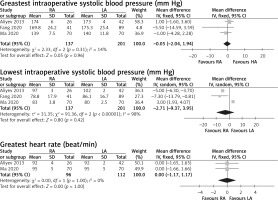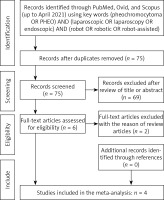Introduction
Pheochromocytoma (PHEO) is a rare neuroendocrine tumour that originates in the adrenal medulla or extra-adrenal glands [1]. In the general population, the estimated incidence of PHEO is between 0.05% and 0.1% [2]. Typical clinical manifestations include paroxysmal hypertension, sweating, headache, and palpitations caused by excessive catecholamine secretion, which endanger patients’ lives [3]. Adrenalectomy is considered the gold standard for PHEO [1, 4]. Open adrenalectomy has been considered the gold standard for a long time. However, laparoscopic adrenalectomy (LA) has replaced open adrenalectomy as the ‘‘gold standard’’ since the 1990s [5]. With the widespread application of robotic surgery, the application of robotic adrenalectomy (RA) is increasing. Robotic surgery has the following advantages: wristed instrument to eliminate tremors, flexible and intuitive instrument control, and highly visual three-dimensional vision [6]. However, the longer learning curve, longer operative time, and higher costs limit the application of robotic surgery [7]. In addition, due to the lack of tactile feedback during dissection of PHEO, RA could increase the risk of bleeding, cardiovascular accidents, and intraoperative hypertensive crisis [8].
Whether RA is more feasible for PHEO than LA is still controversial. In order to better understand the ongoing debate, it is necessary to analyse the current evidence and draw objective conclusions. The goal of this study is to perform a meta-analysis to evaluate the efficacy and safety of RA versus LA when treating patients with PHEO.
Aim
The aim of the study is to evaluate the efficacy and safety of RA versus LA when treating patients with PHEO in terms of operative time, estimated blood loss (EBL), transfusion, conversion rate, peri-operative haemodynamic outcomes, complications, Clavien-Dindo score ≥ 3 complications, and length of hospital stay.
Material and methods
Literature search
A systematic literature search of the PubMed, Ovid, and Scopus databases (up to April 2021) was performed to identify studies comparing RA and LA. The search strategy was “(pheochromocytoma OR PHEO) AND (laparoscopic OR laparoscopy OR endoscopic) AND (robot OR robotic OR robot-assisted)”. The Preferred Reporting Items for Systematic Reviews and Meta-analysis (PRISMA) criteria was used for article selection (Figure 1). Two investigators (LD and ZY) screened the titles and abstracts of potentially eligible studies independently. Relevant references were also checked for additional studies.
Inclusion and exclusion criteria
Inclusion criteria: (1) original studies comparing RA to LA for PHEO; (2) written in English language; (3) adult studies only.
Exclusion criteria: (1) children’s studies; (2) studies including paraganglioma; (3) studies without primary or sufficient data (i.e. reviews, commentaries, conference abstracts).
Data extraction and quality assessment
Data were extracted independently by 2 researchers (LD and ZY) using a predefined data extraction form, including demographic characteristics (age, gender, BMI, tumour size, and tumour side), peri-operative outcomes (operative time, EBL, transfusion, and conversion), peri-operative haemodynamic outcomes (greatest intraoperative systolic blood pressure, lowest intraoperative systolic blood pressure, and greatest heart rate), and post-operative outcomes (complications, Clavien-Dindo score ≥ 3 complications, and length of hospital stay). Any discrepancy was resolved in consultation with JQ. Two researchers (LD and ZY) independently assessed the evidence level of the included studies according to the Oxford Centre for Evidence-based Medicine (Table I).
Statistical analysis
Cochrane Collaboration’s Review Manager (RevMan) 5.4 software (Cochrane Collaboration, Oxford, UK) was adopted to analyse the effects of the outcomes. Because only means and standard deviations are permitted for continuous data in RevMan 5.4, a validated mathematical model was used to convert median (range) to mean (standard deviation) for studies only reporting medians and ranges [9]. Heterogeneity was defined based on the Cochrane Q p-value and I 2 statistic. If p > 0.1 or I2 < 50%, a fixed-effects model was used. While, if p < 0.1 or I2 > 50%, a random-effects model was used. A p < 0.05 was considered statistically significant. To evaluate publication bias, funnel plots were examined.
Results
Overall, 4 studies including 386 patients (RA 155; LA 231) were included in this study (Figure 1) [10–13]. Table I shows the basic characteristics and quality assessment of the included studies.
There were no statistically significant differences between RA and LA in age (WMD = –0.55 years, 95% CI: –5.48 to 4.38; p = 0.83), male component (OR = 1.00, 95% CI: 0.66 to 1.51; p = 1.00), BMI (WMD = 0.54 kg/m2, 95% CI: –0.98 to 2.06; p = 0.49), and tumour side (OR = 1.01, 95% CI: 0.67 to 1.52; p = 0.97) [10–13]. Meta-analysis of these studies showed larger tumour size in the RA group (WMD = 0.72 cm, 95% CI: 0.31 to 1.13; p < 0.001) [10–13] (Figure 2).
Figure 2
Forest and funnel plots of demographic characteristics of robotic adrenalectomy (RA) vs. laparoscopic adrenalectomy (LA) for pheochromocytoma (PHEO)
BMI – body mass index, SD – standard deviation, CI – confidence interval.


All the 4 studies reported operative time and EBL [10–13]. There were no significant differences in operative time (WMD = –12.49 min, 95% CI: –29.50 to 4.52; p = 0.15) and EBL (WMD = –28.48 ml, 95% CI: –58.92, 1.95; p = 0.07) between the 2 groups. Two studies including 191 patients (RA 89; LA 102) reported transfusion [12, 13]. The transfusion rate was similar between RA and LA (OR = 0.70, 95% CI: 0.07 to 7.07; p = 0.77). Two studies including 205 patients (RA 95; LA 110) reported open conversion [10, 13]. A meta-analysis of these studies showed comparable conversion rates for RA and LA (OR = 0.44, 95% CI: 0.07 to 2.88; p = 0.39) (Figure 3).
Figure 3
Forest and funnel plots of peri-operative outcomes of robotic adrenalectomy (RA) vs. laparoscopic adrenalectomy (LA) for pheochromocytoma (PHEO)
EBL – estimated blood loss, SD – standard deviation, CI – confidence interval.

Three studies including 338 patients (RA 137; LA 201) reported the greatest intraoperative systolic blood pressure and lowest intraoperative systolic blood pressure [10, 11, 13]. A meta-analysis of these studies showed similar greatest intraoperative systolic blood pressure (WMD = –0.05 mm Hg, 95% CI: –2.04, 1.94; p = 0.96) and lowest intraoperative systolic blood pressure (WMD = –2.71 mm Hg, 95% CI: –9.37, 3.95; p = 0.42). Two studies including 208 patients (RA 96; LA 112) reported greatest heart rate [10, 13]. There was no statistically significant difference in greatest heart rate (WMD = 0.00 beat/min, 95% CI: –1.17, 1.17; p = 1.00) (Figure 4).
Figure 4
Forest and funnel plots of peri-operative hemodynamic outcomes of robotic adrenalectomy (RA) vs. laparoscopic adrenalectomy (LA) for pheochromocytoma (PHEO)
SD – standard deviation; CI – confidence interval.

All the 4 studies reported postoperative complications, Clavien-Dindo score ≥ 3 complications, and length of hospital stay [10–13]. There were no significant differences between the 2 groups in terms of postoperative complications (OR = 1.06, 95% CI: 0.62 to 1.82; p = 0.84) and Clavien-Dindo score ≥ 3 complications (OR = 1.15, 95% CI: 0.39 to 3.41; p = 0.80). A meta-analysis of these studies showed shorter length of hospital stay for RA (WMD = –0.51 days, 95% CI: –0.91 to –0.12; p = 0.01) (Figure 5).
Figure 5
Forest and funnel plots of post-operative outcomes of robotic adrenalectomy (RA) vs. laparoscopic adrenalectomy (LA) for pheochromocytoma (PHEO)
SD – standard deviation, CI – confidence interval.

There was no significant publication bias in this study.
Discussion
Adrenalectomy is still the gold standard treatment for PHEO. There are several different techniques available for adrenalectomy: open adrenalectomy, laparoscopic adrenalectomy, and robotic adrenalectomy. Laparoscopic adrenalectomy has been widely used and considered the gold standard for adrenal tumours [5, 14]. However, RA has the advantages of wristed instrument, freedom of movement, amplification effect, and highly visual three-dimensional vision [6, 15]. Whether RA is feasible to LA remains controversial. Therefore, we conducted a meta-analysis of the existing literature and drew objective conclusions on this topic.
In this meta-analysis, patients in the RA group and the LA group were similar in terms of age, gender, BMI, and tumour side. The tumour size was larger in the RA group. This could be the inherent selection bias due to the operative advantages of RA. Most of the studies included in this article reported large PHEOs. The mean tumour size was larger than 4 cm or even 8 cm. Large PHEOs might be related to intense vascularization, adhesion with surrounding tissues, and contracting with inferior vena cava [16]. These would significantly increase the difficulty of dissection. However, we found similar operative time, EBL, transfusion rate, and conversion rate between the 2 groups. This could reflect the superiority of RA in dissection.
Most of the PHEOs are rich in blood vessels and catecholamine-secreting tumours. Haemodynamic crisis is the most challenging factor during the manipulation of the tumour [17, 18]. Due to the lack of tactile feedback, many researchers were concerned about the risk of bleeding, cardiovascular accidents, and intraoperative hypertensive crisis during the dissection of PHEO [8]. Our study found similar peri-operative haemodynamic outcomes between the 2 groups. This could be explained by the following factors. First, the patients were well prepared for surgery with α-blockers (such as phenoxybenzamine), which could significantly improve perioperative haemodynamic fluctuations [19]. Second, with the help of a wristed instrument and three-dimensional vision, direct tumour manipulation was reduced. Therefore, after adequate preparation, both RA and LA could obtain good perioperative haemodynamic results. These results proved the safety of RA compared with LA.
Our study found that RA did not reduce the complications and Clavien-Dindo score ≥ 3 complications. However, the length of hospital stay in the RA group was significantly shorter than that in the LA group. This could be related to the precise dissection and less interference of RA. This demonstrated that the efficacy of RA was similar to that of LA.
This study has several limitations. First, most of the studies were retrospective, which limited the quality of the results. Second, the small sample size of patients reduced the reliability of the results. Third, preoperative fluid and hypotensive drug administration were not standardized. Fourth, the robotic or laparoscopic approaches were not consistent. Fifth, it was not possible to analyse the oncological results. Sixth, long follow-up was required to verify the results. And last but not least, we did not have sufficient data to analyse the learning curve and cost. More multicentre randomized controlled trials are needed to focus on this topic, especially haemodynamic stability.









